Таблиці для викладання англійської мови
В даній папці зібрані картинки з мережі інтернет для викладання англійської мови в школі. Також ці картинки можна використовувати для самоосвіти, або ж як я для проведення додаткових занять з анлійської мови вдома.
- 1454765770.jpg jpg
- 1454765774.jpg jpg
- 1454765778.jpg jpg
- 1454766431.jpg jpg
- Показати всі файли





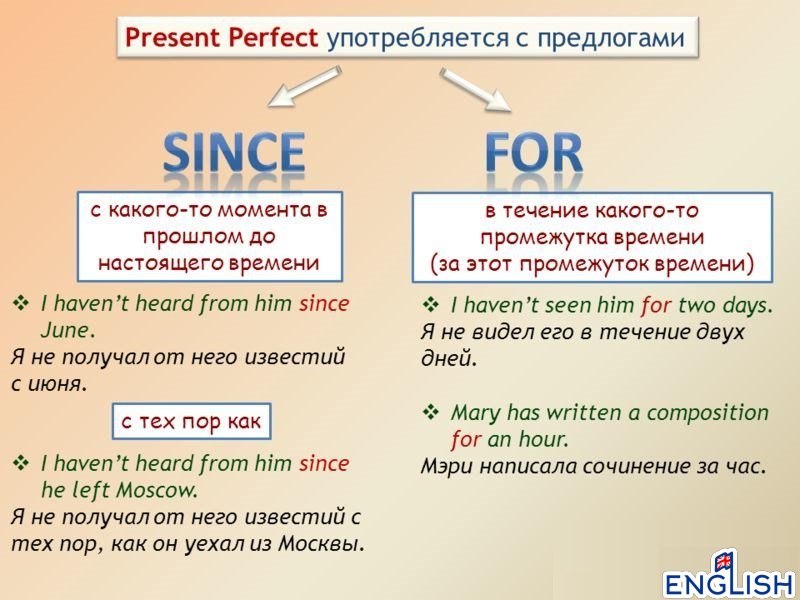



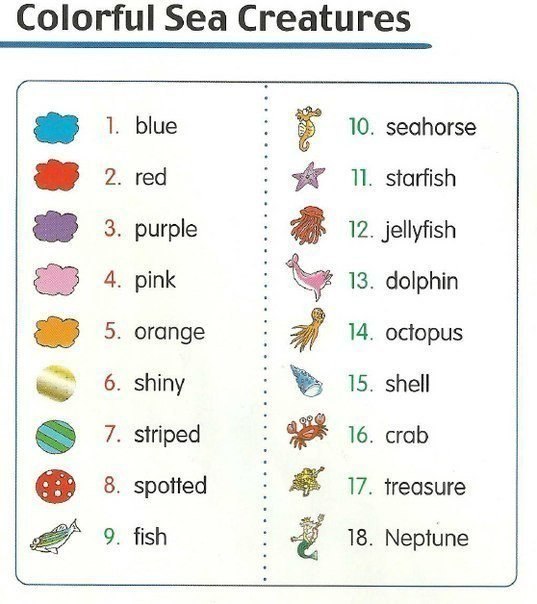
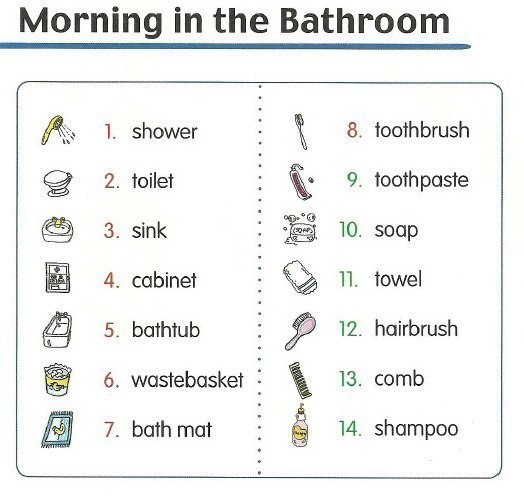
















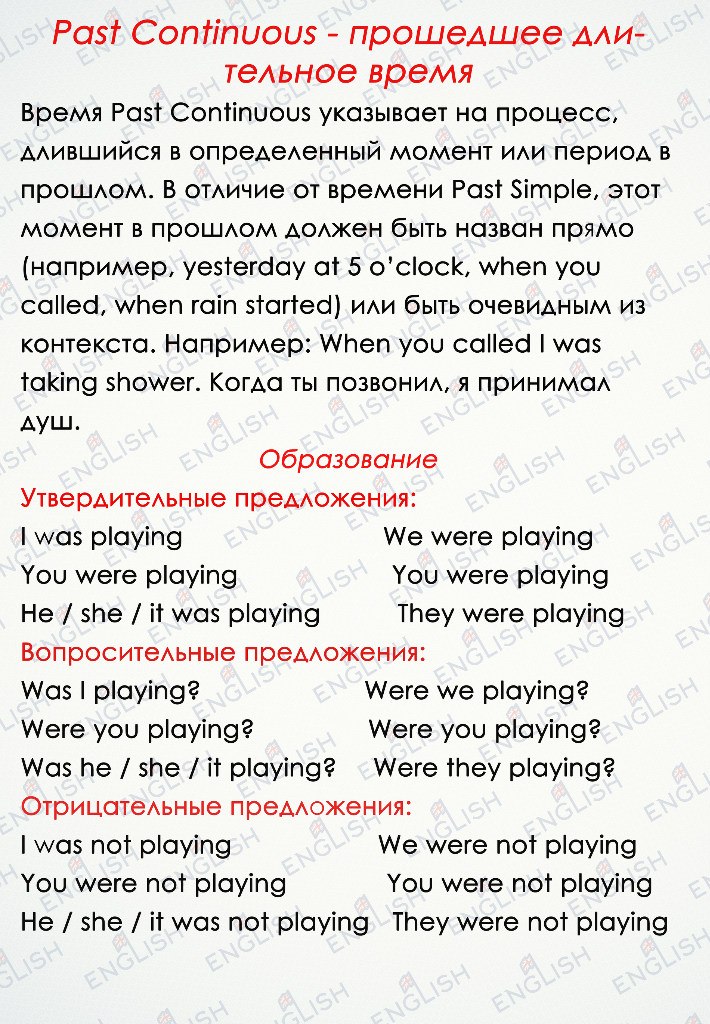
















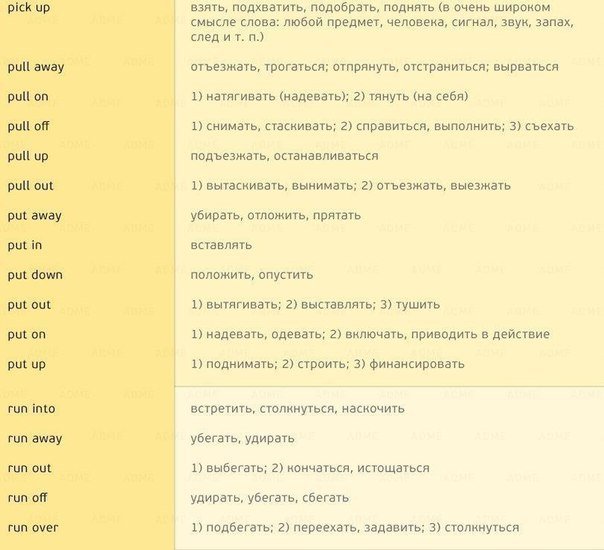
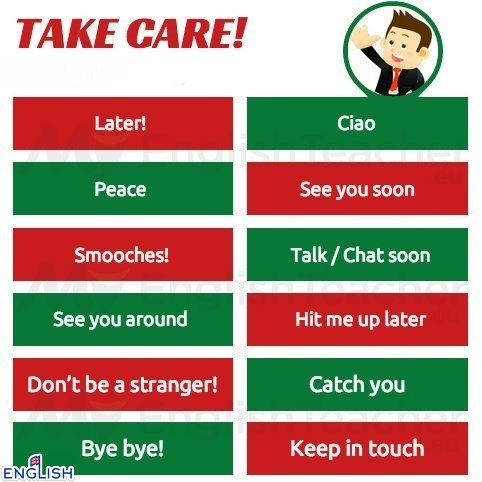
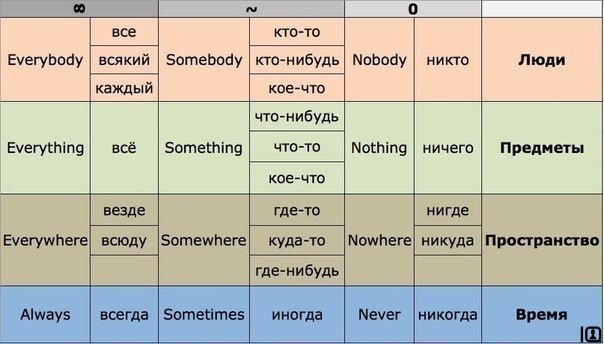













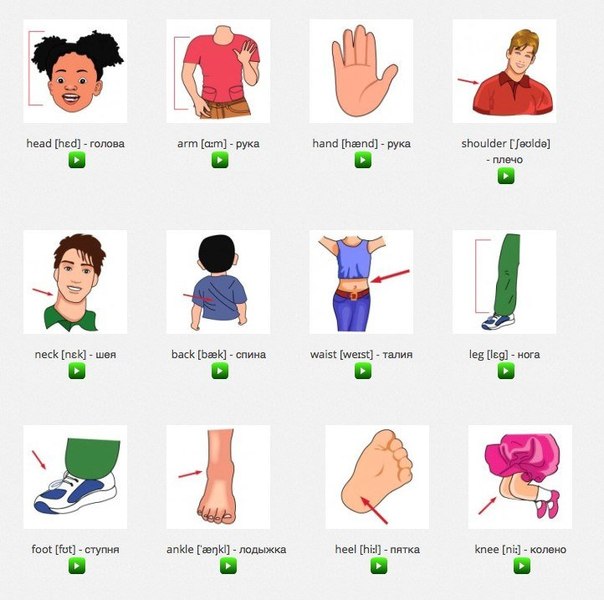


















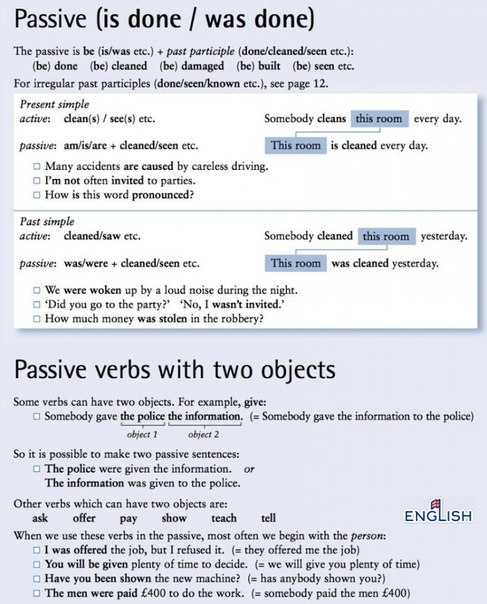







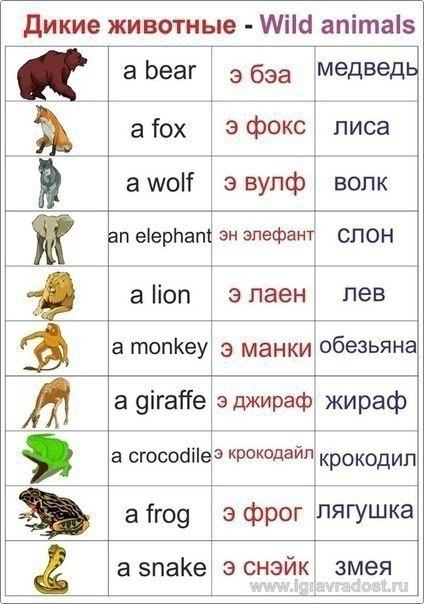





9 клас
LEVEL 1
Task 1
Choose the correct words to fill in the gaps (10 балів – кожна правильна відповідь – 2 бали)
-
He _____ he was going to visit his sister in Ohio.
- spoke that
- talked that
- said that
- told that
-
The theater performance _____.
- succeed
- successful
- was success
- was a success
-
“Why are you rushing?” “I have _____ with my doctor.”
- an appointment
- a pledge
- a promise
- a contract
-
Since the rainstorm came _____, it did a lot of damage in the area.
- surprisingly
- rapid
- in hurry
- suddenly
-
_____ my childhood, I studied in Paris.
- During
- Ever
- When
- While
Task 2
Complete the sentences with the correct words.(10 балів – кожна правильна відповідь -2 бали)
-
This is the _____ curry sauce I’ve ever tasted.
- more good
- most good
- best
- most best
- If Jane asks her mother, she _____ permission.
- may have gotten
- might have gotten
- might get
- maybe get
- My sister lived in France for two years and my niece _____ there.
- borned
- born
- was borned
- was born
- He likes his new job very much and _____.
- works hardly
- hard works
- hardly work
- works hard
- “Where does Helen live?” “She lives _____.”
- in the Moore Street
- on Moore Street
- at Moore Street
- on the Moore Street
LEVEL 2
Task 1
Read the paragraphs (1-5) and match them with the titles (A-F)
(10 балів – 2 бали правильна відповідь)
Titles
- A rest in a small cafeteria
- A great surprise
- A package of doughnuts under the gentleman’s newspaper
- The gentleman’s decision to ignore the unusual situation
- A visit to Chicago
Unusual Situation
1. A funny thing happened to me last Friday. I’d gone into Chicago to do some shopping. I wanted to find a book for my psych course. I had gotten to the city early, so by early afternoon I’d done everything that I wanted. Anyway I’m not crazy about downtown Chicago – all the noise, the traffic, strange people – and I’d made plans for that evening.
2. I just wanted to get in my car and drive home before the rush hour, but I felt really tired. I decided that I had time for a cup of coffee and a short rest. I bought the ‘Tribune’ and went to a small cafeteria. I got a cup of coffee and a package of doughnuts – I’m crazy about cakes. There were plenty of empty tables, and I found one near the window. I sat down and started the crossword puzzle in the paper.
3. A few minutes later a woman sat down across from me at my table. That surprised me because there were several empty tables. There was nothing strange about her except that she was very tall. I didn’t say anything; I just kept doing the crossword.
4. Suddenly she reached across the table, opened my package of cakes, took one out, dunked it in her coffee, and began to eat it. I couldn’t believe my eyes! I was too shocked to say anything. Anyway I didn’t want to make a scene, so I decided to ignore it. I just took a cake myself and went to my crossword.
5. When the woman took a second cake I didn’t make a sound. I pretended to be very interested in the puzzle. A few minutes later I casually put out my hand, took the last cake, and glanced at the woman. She was staring at me furiously. I nervously started eating the cake and decided to leave. I was ready to get up and go when the woman suddenly pushed back her chair, stood up and hurried out of the cafeteria. I felt relieved and decided to wait for two or three minutes before going myself. I finished my coffee, folded my newspaper and stood up. And there, on the table, where my paper had been, was my package of doughnuts.
Task 2
Read the text and say whether the sentences below the text are “true” or “false” (10 балів – 1 бал правильна відповідь)
Living in the countryside can be very difficult for teenagers. Their nearest friend lives miles away and it’s impossible to get into the town to go shopping or attend a club. 13-year-old Fiona Timson, who lives in Carneath in Wales, says ‘Everyone else in my class seems to have such interesting weekends. They meet each other by chance when they’re out shopping, and they decide there and then to do something cool together. That never happens to me.’
Fiona’s mum, Helen, 1rganiza it’s a problem. ‘We moved here because it was quiet and we knew we wouldn’t have to worry about her going out alone. But we possibly made the wrong choice. Fiona hardly ever leaves home, not because she’s scared, but because there is simply nowhere for her to go. The village is tiny, and most of the people living here are old. I can’t drive her around because we only have one car, and my husband uses it for work.’ Fiona can’t spend the evening with friends because the last bus to Carneath is at ten past five in the afternoon. She even has to leave her school orchestra practice early in order to catch it.
The Country Kids 1rganization aims to help children like Fiona, and their families. A grant from Country Kids gives families money for four taxi rides per month, up to a distance of twenty five miles each. This allows children like Fiona to attend an after-school club once per week or visit friends on Sundays. Country Kids also organizes trips to theatres and sports events in nearby cities at weekends. The parents don’t have to do anything. A minibus comes directly to the house and picks the kids up.
To qualify for a grant from Country Kids, children must be between the ages of eleven and sixteen, and live in a village with a population of less than 1000 people. The village must be more than twenty miles from a town. The family’s income must also be below a certain level. For Fiona’s schoolfriend Emma, who lives in nearby Dolbury with a population of 894, it’s perfect. Unfortunately, Fiona misses out. The population of Carneath is 1159.
The number of families applying to Country Kids for a grant is increasing, and its president, Judith Sankey, is finding it more and more difficult to find funding. ‘There are so many great 1rganization1 looking for money. A lot of people feel that curing diseases and helping animals is more important than the work we do, so they prefer to give their money to them. We’re always worrying that we won’t be able to carry on. But the families we help really do appreciate what we do, so I hope the 1rganization can continue to run in the future.’
- Fiona would like to have fun without having to making plans.
- Fiona’s family moved to the countryside because of their work.
- Fiona’s mother does not allow Fiona to go out alone.
- Very few children and teenagers live in Carneath.
- Fiona is unable to play in the school orchestra because of where she lives.
- A child with a Country Kids grant gets free transport home twice per week.
- Country Kids pays for children to see plays in nearby towns.
- Fiona doesn’t qualify for a Country Kids grant because her family earns too much.
- Fewer and fewer families are requesting money from Country Kids.
- Judith Sankey is worried that the Country Kids 1rganization may close down.
Task 3
Match the following idioms with their definitions(10 балів – 2 бали правильна відповідь)
- not worth the candle
- soft shoe
- pig in clover
- stuffed shirt
-
scarce as hen’s teeth
- a person who is very serious or formal
- a speech given in a gentle or conciliatory way
- something that is extremely rare
- someone who is very happy and pleased
- a waste of time and effort
LEVEL 3
Task 1 (Listening)
1. Listen to the text. Are the sentences true or false?(15 балів -1 бал правильна відповідь)
- Askania-Nova is one of the most ancient nature reserves even in the world.
- Scientists have used Askania-Nova for their research for nearly a century.
- It is situated in the eastern steppes of Ukraine.
- Phalts-Phein was a German duke.
- The virgin reserve steppe is divided into three parts.
- The steppe is especially beautiful when tulips are flowering.
- In the dendrological park there is a river lined by oaks and willows.
- Many ashes and birches grow in the park.
- Lilacs predominate among the shrubs.
- Fauna conditions are not favourable formartens.
- Green frogs live in the dendrological park.
- It’s impossible to see the European bison in the wild in Askania-Nova.
- Phalts-Phein educated himself.
- It’s usually hot in Askania-Nova in summer.
- Virgian juniper is a kind of locusts.
2. Choose the proper answer (10 балів – 1 бал правильна відповідь)
-
Who moved along its vast territory – Tavrichny steppe?
- Slavonic tribes
- Normandic tribes
- Saxons
- Jutes
-
What is called “baba”?
- A bronze statue
- An old woman
- A stone statue
- A young woman
-
When did a manor of a German duke Angalt-Ketensky called ‘Askania-Nova’ appear?
- At the end of 19th century
- At the end of the 18th century
- In the beginning of 19th century
- In the beginning of 18th century
-
Why was Askania called in such a way?
- In the memory of the German estate
- German duke liked that name
- In the memory of the Belgian estate
- In the memory of the French estate
-
Who bought that large manor?
- A Ukrainian earl
- A biologist
- A French earl
- A scientist
-
What did Phalts-Phein establish there?
- Disneyland
- A lake and virgin lakes
- An aqua park
- A unique zoo and dendropark
-
What year is considered to be the year of founding Askania-Nova?
- 1890
- 1898
- 1895
- 1896
-
How long does the virgin reserve steppe stretch?
- 20 km from west to east and 9 km from north to south
- 25 km from west to east and 10 km from north to south
- 26 km from west to east and 9 km from north to south
- 30 km from west to east and 10 km from north to south
-
How many parts is it divided into?
- 3
- 4
- 2
- 5
-
When is the steppe the brightest?
- In summer
- In spring
- In autumn
- At night
Task 2 (Writing) (25 балів)
- Message in a Bottle: If you were stranded on a deserted island and could send out one message in a bottle, what would you write in that message, and why would you write those particular things?
- A New Olympic Sport: Invent a new Olympic sport. There are many unusual Olympic sports, like skeleton (running and then sledding), biathlon (skiing plus shooting), and curling (using brooms to propel an object over ice). Make up a new sport that would be fun to watch and play.
Listening comprehension
Askania-Nova nature reserve is one of the most ancient in Ukraine and even in the world and has been a base of wide scientific research for about one hundred years. It is located in the southern steppes of Ukraine in the driest part of the Black Sea lowlands between the Dnieper and the Molochna. In the times gone normadic tribes moved along its vast territory — Tavrichny steppe. Some of them left behind stone statues called ‘baby’. At the end of the 18th century large manors became to appear there. One of them was a manor of a German duke Angalt-Ketensky called ‘Askania-Nova’ in the memory of his estate ‘Askania’ in Germany. Then it was sold to a highly-educated biologist Phalts-Phein who did his best for preserving fauna and flora in the area. He established a unique zoo and dendropark. In 1898 he selected a new plot of virgin lands and proclaimed it to be ‘defended forever’. This year is considered to be the year of founding the steppe nature reserve Askania-Nova.
The climate of the reserve is continental with hot dry summer and changeable mild winter.
The virgin reserve steppe is the centre of Askania-Nova. It stretches for 20 km. from west to east and 9 km. from north to south. It is divided into three separate parts: Southern, Northern and Big Chapelsky.
Cereals prevail in the zone crop of grass though their number isn’t more than 15 species. The feather grass defines the most colourful and typical aspect of the reserve virgin land. But the most beautiful and the brightest steppe is undoubtedly in spring. It is the time of tulip flowering.
A part of the reserve territory is covered with parks: Old Park, New Park and the Ornithological park: we can observe various kinds of trees and shrubs in the reserve. The old dendrological park was founded in the landscape style where trees and shrubs alternate with picturesque glades everywhere. There is a pond surrounded by oaks, willows and poplars in the centre of the park. The main types of trees in Askania-Nova parks are ashes, black locusts and conifers (Crimean pine and Virginian juniper). Among shrubs the lilacs predominate.
Fauna of the steppe is unique. It is influenced by plain relief, plants and climate. But conditions are not favourable for amphibians. Almost the only their representative is a green frog. 21 species of birds have their nests in the virgin steppe. Not a long time ago the roe deer and the noble deer appeared in the steppe reserve again. The rarest animals are concentrated in the zoo. They are the horse of Pryzhewalsky, the European bison, the fallow deer, the zebra, the ostrich, etc.
Askania-Nova is a place where complex study of nature is carried out and a great number of flora and fauna species are preserved for future generations.
10 клас
LEVEL 1
Task 1
Choose the correct words to fill in the gaps (10 балів – 2 бали правильна відповідь)
-
We had no idea who the special guest speaker would be, because the organizers of the event were so _____.
- animated
- secretive
- talented
- emotional
-
Cindy had some _____.about marrying George, because he was sometimes violent.
- enthusiasm
- ignorance
- trepidation
- urgency
-
I am slow to _____.
- express my opinion
- express my viewing
- make my views
- make my opinion
-
The car was parked directly _____ the diner.
- before
- ahead of
- in front of
- preceding
-
How long did the baseball game _____?
- last
- endure
- survive
- continue
Task 2
Complete the sentences with the correct words (10 балів – 2 бали правильна відповідь)
-
I've never seen _____.
- such a tall man
- so tall man
- such tall man
- as tall man
-
John started his current job _____ October 10.
- at
- on
- in
- to
-
Would you go with us if you _____ the money?
- will have
- have
- would have
- had
-
.I wish I _____ with Ann.
- am
- be
- were
- would be
-
Until last year, she was the largest ship that _____.
- was ever built
- has ever built
- has ever been built
- had ever been built
LEVEL 2
Task 1
Read the texts (A-E) and match them with the titles (1-6) (10 балів -2 бали правильна відповідь)
Titles
- Multiple sporting skills
- Teething troubles
- Disputed achievements
- Unparalleled achievements
- Questionable behaviour
A. Sonja Henie was born in Kristiania, current Oslo. Her father had been a one-time World Cycling Champion and the Henie children were encouraged to take up a variety of sports at a young age. Henie initially showed talent at skiing, and then followed her older brother Leif to take up figure skating. As a girl, Henie was also a nationally ranked tennis player and a skilled swimmer and equestrienne. Once Henie began serious training as a figure skater, her formal schooling ended. She was educated by tutors, and her father hired the best experts in the world, including the famous Russian ballerina Tamara Karsavina, to transform his daughter into a sporting celebrity.
B. Henie won her first major competition, the senior Norwegian championships, at the age of 10. She then placed eighth in a field of eight at the 1924 Winter Olympics, at the age of eleven. During the 1924 program, she skated over to the side of the rink several times to ask her coach for directions. But by the next Olympiad, she needed no such assistance.
C. Henie won the first of an unprecedented ten consecutive World Figure Skating Championships in 1927 at the age of fourteen. The results of 1927 World Championships, where Henie won in a 3-2 decision (or 7 vs. 8 ordinal points) over the defending Olympic and World Champion Herma Szabo of Austria, were controversial, as all three of five judges that placed Henie first were Norwegian while Szabo received first-place ordinals from an Austrian and a German judge.
D. Henie went on to win the first of her three Olympic gold medals the following year. She defended her Olympic titles in 1932 and in 1936, and her World titles annually until 1936. She also won six consecutive European championships from 1931 to 1936. Henie's unprecedented three Olympic gold medals haven't been matched by any ladies single skater since; neither are her achievements as ten-time consecutive World Champion.
E. Towards the end of her career, she began to be strongly challenged by younger skaters. However, she held off these competitors and went on to win her third Olympic title at the 1936 Winter Olympics, albeit in very controversial circumstances with Cecilia Colledge finishing a very close second. Indeed, after the school figures section at the 1936 Olympic competition, Colledge and Henie were virtually neck and neck with Colledge trailing by just a few points. The closeness of the competition infuriated Henie, who, when the result for that section was posted on a wall in the competitors' lounge, swiped the piece of paper and tore it into little pieces. The draw for the free skating then came under suspicion after Henie landed the plum position of skating last, while Colledge had to perform second of the 26 competitors, which was clearly in Henie’s favor.
Task 2
Read the text and say whether the sentences below the text are "true" or "false" (10 балів – 1 бал правильна відповідь)
Explore the Villages around Hartbridge
Many visitors come to Hartbridge to see the wonderful art galleries and museums, the beautiful buildings and the fantastic parks. Few people go outside the city, and so they miss out on experiencing the scenery and the fascinating history of this beautiful area. This brochure will tell you what you can see if you take a short bus ride out of the city.
Camberwell
The historic village of Camberwell was once the home of the wealthy Hugo family. They lived in a huge country house, Camberwell Court, and owned all the land in the area. The family sold their house in the 1940s, and it is now open to the public. You can spend a whole day walking around the house and gardens. There is a small exhibition about the family, a children’s play area, a gift shop and a restaurant. But the village of Camberwell is also worth a visit. There are some beautiful cottages with well kept gardens, and there is a small church which dates back to the eleventh century. To get to Camberwell, take Bus 46 from the Bus station. Buses leave every two hours.
Hidcot
Hidcot is an attractive village situated on the River Owell. Wildlife lovers should visit the Nature Park to the south of the village, where there are large numbers of rare birds and flowers. However, you will probably see plenty of wildlife from the bridge in the village centre! In Hidcot, you can take a two-hour river cruise - a great way to see the countryside and learn about the local wildlife from a guide. If you prefer to explore the river by yourself, it’s well worth walking one and a half miles along the river to the pub ‘The Boat’ which cannot be reached by road. Here, you can hire small boats and explore the river at your leisure. To get to Hidcot, take Bus 7A to Reeford. Hidcot is half way between Hartbridge and Reeford.
Tatterbridge
The beautiful village of Tatterbridge was home to the children’s writer Jane Potter, whose stories of Benjamin Bear are loved by adults and children around the world. Jane Potter’s home is now a museum and tea shop, and is well worth a visit just for its wonderful gardens. It also has a gift shop where you can buy souvenirs and books. Tatterbridge has a number of interesting shops including an excellent cake shop, and ‘Wendy’s Giftshop’ where you can find lots of unusual gifts made by hand by local artists. Lovers of Jane Potter’s books should also walk to the Green Valley woods, which have not changed since Jane Potter wrote her stories there one hundred years ago.
To get to Tatterbridge, take Bus 4 from outside the cinema. It takes about 40 minutes to get there.
Moordale
This old industrial village is the highest village in the area. Here in the hills, coal was found in the late eighteenth century, and people came here in great numbers to take it out of the ground and transport it to the nearby towns. Many industries grew up in the area, including a paper factory and a cotton factory. The industries all closed down in the nineteenth century, and since then Moordale has gone back to being a quiet farming village. However, if you walk from the village centre up the steep hill to the north, you can still see the paths where horses used to carry the coal. There is a four mile walk around the village which has some amazing views, but walkers are must be careful as the path is steep in places and they could slip. To get to Moordale, take Bus 7A to Reeford, and then take the number 38 bus to Moordale.
- It is unusual for visitors to visit the villages near Hartbridge.
- The Hugo family allows people to visit their current home.
- The leaflet advises visitors not to spend all day at Camberwell Court.
- You can hire small boats from the bridge in Hidcot.
- You can take the bus directly to ‘The Boat’ pub near Hidcot.
- The leaflet says that the gardens are the best part of Jane Potter’s home.
- Jane Potter wrote her books in the Green Valley woods.
- You can visit the paper factory and the cotton factory in Moordale.
- You will see horses on farms as you walk around Moordale.
- You can get to all four villages directly from Hartbridge.
Task 3
Match the following idioms with their definitions ( 10 балів – 2бали правильна відповідь)
- an arm and a leg
- beat a dead horse
- cross your fingers
- get down to brass tacks
-
hit the books
- become serious about something
- hope that something happens the way you want it to
- very expensive, a large amount of money
- study, especially for a test or exam
- force an issue that has already ended
LEVEL 3
Task 1 (Listening)
1. Listen to the text. Are the sentences true or false? (10 балів – 1 бал правильна відповідь)
- On Christmas Eve Marcy went caroling with all members of her family.
- Marcy wished wonderful Christmas spirit would last the whole year.
- After the round of singing Marcy went to the church.
- The fur tree was decorated with blue lights.
- There weren’t any presents under the Christmas tree.
- Mom worked at the hospital on Christmas Day.
- When the kids were little Dad used to work on Christmas Day.
- Marcy helped her mom to get Christmas dinner.
- To Marcy’s mind, Christmas was over too soon.
- On Christmas, Marcy made some calls to greet a few old friends.
2. Choose the proper answer (15 балів – 1 бал правильна відповідь)
-
The first paragraph of the passage mainly describes
- The weather on Christmas Eve
- Christmas decoration of various houses
- Marcy’s plan for the coming year
- Marcy’s inner feelings
-
The snow in the street was
- melting
- soft
- fluffy
- sparkling
-
The crowd went back to Marcy's and Ken's house
- to go carolling
- after watching the fireworks
- after carolling
- to watch the fireworks
-
What Christmas food was not mentioned in the passage?
- hot cider
- ginger bread
- fruit cake
- cookies
-
Besides the lights the fur tree was decorated with
- a silver tinsel
- chocolate candies
- an angel
- beautiful candles
-
The fur tree was decorated by
- Mom and Dad
- Marcy
- Marcy and Ken
- Ken
-
On Christmas Eve the guests were treated to drinks and snacks
- in front of the fireplace
- in a cozy cafe
- in the kitchen
- outdoors
-
Mom wouldn't have to work on
- Christmas Eve
- Christmas Day
- Boxing Day
- the weekend
-
Mom arranged to trade time with one of the
- unmarried nurses
- married nurses
- unmarried doctors
- married doctors
-
What did Tom intend to do if he was for hitting the sack?
- to have a glass of Champaign
- to wait for Santa Clause
- to hide the presents under the tree
- to go to bed
-
If Marcy is naturally curious she’ll be up _____ to see what she got for Christmas.
- at 9 a.m.
- at midnight
- at noon
- at the crack of the dawn
-
In Marcy’s opinion except in one respect Christmas was
- absolutely dull
- absolutely perfect
- absolutely unhappy
- absolutely disorganized
-
On Christmas Day the kitchen was
- empty
- burned down
- cold
- delicious-smelling
-
Marcy and Ken are
- cousins
- siblings
- a married couple
- close friends
-
Some ______ stepped in and lingered a little while, talked and laughed.
- nurses
- neighbours
- relatives
- friends
Task 2 (Writing) (25 балів)
- A New Name for Your Town/City: If you could rename your town or city, what would you call it? Why did you pick this name? How would it change things in your town?
- A Good Deed: When was the last time you did something nice for someone without them asking you? Write about what it was that you did and why you did it. How did the other person react, and how did you feel about your good deed? What about next time?
Listening comprehension
From A Man for Marcy by Rosamond du Jardin
On Christmas Eve Marcy went carolling with a crowd of friends. Standing in the soft drifted snow outside the various houses they stopped at, singing all the sweet old songs that seemed so much a part of Christmas, Marcy felt the deep, abiding sense of happiness the season always engendered in her. If only, she thought, people could always feel warm and close to each other as they did at this special time of year. If only some of its wonderful spirit could carry over into all the months to come, how fine it would be for the weary battered old world.
After their round of singing was over, the crowd went back to Marcy's and Ken's house for hot cider and fruit cake and Christmas cookies in front of the roaring fire. The tree, which Marcy and Ken had decorated that afternoon, glittered with varicolored lights and silver tinsel. And under it all the intriguing packages had come out of hiding to be stacked in a gay drift of red and green and gold and silver.
The crowd didn't stay too late. They were having fun, but Christmas Eve wasn't a staying-out-late sort of time. Mom and Dad along with Marcy and Ken waved good night to them from the front door and the chill air echoed with cries of "Merry Christmas." Then the whole family wandered back to the living room, their arms affectionately across each other's shoulders.
Mom, who had arranged to trade time with one of the unmarried nurses at the hospital and so wouldn't have to work on Christmas Day, said, "Isn't it wonderful to think we're all going to be together tomorrow?"
Dad nodded. "Like old times when the kids were little."
Ken agreed, yawning, "It'll be swell. But I'm for hitting the sack pretty soon. If I know my sister, she'll be up at the crack of dawn to see what she got for Christmas."
"Can I help it," Marcy laughed up at him, "if I'm just naturally curious?"
Christmas was absolutely perfect, Marcy felt, except in one respect. It was over too soon. From the moment when they all came trooping downstairs in robes and slippers, until bedtime that night, it seemed as though only an hour or so elapsed. So many things went to make up all the rush and confusion of a happy holiday. Gifts to open and admire.Dinner to get, working with Mom in the warm, delicious-smelling kitchen.Neighbors dropping in and lingering a little while, talking and laughing. Some calls for them to make on a few old friends.
11 клас
LEVEL 1
Task 1
Choose the correct word to explain the words in italics (10 балів – 2 бали правильна відповідь)
-
That perfume always evokes pleasant memories.
- angers
- erases
- calls up
- confuses
- Mark seems very pensive today.
- writing
- hostile
- cooped-up
- thoughtful
- The air in the rainforest was humid, making the heat seem even more smothering than before.
- hot
- damp
- hazy
- volatile
- Because of his disregard for the king’s laws, the prince was punished by being banished from the kingdom.
- apart
- kidnapped
- exiled
- spirited
- The volcano lies dormant now, but we feel sure that it will erupt again within the year.
- inactive
- slack
- elevated
- inattentive
Task 2
Complete the sentences with the correct words (10 балів – 2 бали правильна відповідь)
- She _____ the letter on the office desk.
- lay
- lied
- laid
- lain
- If one is to learn a language well, _____.
- it must be spoken regularly
- one must be spoken regularly
- it must speak regularly
- one must speak it regularly
- _____ me for a few minutes?
- Would you to help
- Would you helping
- Would you mind to help
- Would you mind helping
- Ann is very temperamental. How do you _____ her?
- put up with
- put with
- put up to
- putting up with
- He managed _____ his way through the maze.
- to find
- to find out
- to found
- to found out
LEVEL 2
Task 1
Read the texts (1-6) and match the titles with the paragraphs (A-E) (10 балів – 2 бали правильна відповідь)
- Finding the evidence
- What's in a name?
- Small but significant
- An impossible idea
- Putting it all together
1. Meet Mesosaurus, a small reptile which lived in fresh-water lakes and streams millions of years ago during the lower Permain age. Mesosaurus has had a big impact on how we view our planet, because he helped to prove the existence of the super-continent called Gondwanaland.
2. Every schoolchild has probably looked at a map of the earth and noticed how Africa and South America fit together like pieces of a giant jigsaw, yet until just over a hundred and fifty years ago, no-one believed that this was more than an odd coincidence. It seemed impossible that the massive continents of the earth could ever be moved, let alone so far apart that they ended up half a planet from each other.
3. Nevertheless, in 1912 Alfred Wegener, a German meteorologist came up with the theory that the continents of the earth had all existed in a single mass, which he called Pangaea (which is Greek for “all the world”) Later researchers decided that Pangaea had been two continents, one to the north of the other, which had existed about 250 million years ago. From the geological evidence found in the Gondwana area of India, an Austrian geologist, Eduard Suess coined the name 'Gondwanaland' for the southern supercontinent, of which India was once a part. (The northern continent was called Lurasia.)
4. For many years super-continents were regarded as an interesting theory, but no-one knew how it might work in reality. Then the discovery of the mechanisms of plate tectonics showed how continents might drift across the face of the globe. Once it was accepted that the continents were floating on currents of lava, more evidence became apparent. A particular type of an early plant, the seed fern, was found on continents now scattered about the southern hemisphere of the world, as were tillates, a deposit left by glaciers in the Permo-Carboniferous era of 520 million years ago. And Mesosaurus, the little fresh-water reptile, left his remains in West Africa and Brazil. Since Mesosaurus had no way of crossing the Atlantic, researchers realized that it could not be coincidence that this reptile had left remains in exactly the place where Africa and South America fit together so neatly.
5. By investigating similarities in animal fossils, different types of plants found in the southern hemisphere but not in the northern hemisphere, and patterns of rock formations, researchers have managed to put the continents of modern-day earth together like a huge jigsaw to make up the vanished super-continent. Sometimes rock formations can be seen to break off at the ocean's edge, to carry on once more thousands of miles away on another continent. The evidence shows that not only were Africa and South America once joined to Antartica, but so were India and Australia, parts of south Western Europe, and Florida.
Task 2
Read the text and say whether the sentences below the text are "true" or "false" (10 балів – 1 бал правильна відповідь)
Disney World
It's Not a Small World, after all...covering 40 square miles, Walt Disney World Resort is about the size of San Francisco or two Manhattan islands. Of the more than 25,000 acres, less than 35 percent has been developed with a quarter designated as a wilderness preserve.
A Cast of Thousands...around 62,000 to be more precise. That's how many people it takes to create the magic at the Vacation Kingdom. Not surprisingly, Walt Disney World Resort is the largest single-site employer in the United States.
What the Well-Dressed Mouse Will Be Wearing...depends entirely on the occasion. Mickey Mouse himself has more than 290 different sets of duds, ranging from a scuba suit to a tuxedo. Minnie Mouse's wardrobe contains more than 200 outfits, including everything from a cheerleader ensemble to evening gowns.
I'm Dreaming of a "Green" Christmas...The 1,500 Christmas trees at Walt Disney World Resort won't be the only "green" holiday delights this season as each Walt Disney World resort hotel will glow with new "conservation" lighting - more than 700,000 LED lights in all. String the bulbs end to end and the strand would stretch for 96 miles or light the path from Jacksonville to Orlando, all while using 1/10th of the power of traditional incandescent bulbs.
Who's Still Thirsty?...More than 75 million Cokes are consumed each year at Walt Disney World Resort along with 13 million bottles of water. Guests also gobble 10 million hamburgers, 6 million hot dogs, 9 million pounds of French fries and more than 300,000 pounds of popcorn.
Gone But Not Forgotten...Walt Disney World Lost and Found is one busy place. Every day an average of 210 pairs of sunglasses are turned in and, since 1971, an estimated 1.65 million pairs of glasses have found their way into the "lost" bin. On an annual basis, Lost and Found cast members collect more than 6,000 cell phones, 3,500 digital cameras, 18,000 hats and 7,500 autograph books.
Strings'n Things...Disney's only full-time harpist entertains diners at Victoria & Albert's, a grand dining experience at Disney's Grand Floridian Resort & Spa.
Bloomin' Beauty...Nearly 12 percent of Walt Disney World property - an area equivalent to nearly 3,000 football fields - is devoted to gardens and maintained landscapes. That's 4,000 acres worth of beauty.
- Walt Disney are not environmentally aware and do nothing for nature.
- Over 60,000 people are employed by Disney.
- Minnie Mouse has more clothes than Mickey Mouse.
- The Christmas trees at Disney this year will be white.
- It is common for people to lose their belongings while on holiday at Disney.
- At Disney you can eat burgers but not hot dogs.
- The Grand Floridian Resort and Spa employs a full time cellist.
- Coke is a more popular drink than mineral water at Walt Disney World Resort.
- Walt Disney World Resort is the largest single-site employer in the world.
- Every day 210 pairs of sunglasses are thrown into the "lost" bins.
Task 3
Match the following phrasal verbs with their definitions (10 балів – 2 бали правильна відповідь)
- to break up
- to give in
- to pass something out
- to warm up
-
to work something out
- to make a calculation
- to end a relationship
- to prepare body for exercise
- reluctantly stop fighting or arguing
- to give the same thing to many people
LEVEL 3
Task 1 (Listening)
1. Listen to the text. Are the sentences true or false? (10 балів – 1 бал правильна відповідь)
- One of humanity's greatest resources is the habit of reading books.
- Borrowed books are the most enjoyable to read.
- A borrowed book should be returned.
- In the author's opinion you don’t have to be afraid of marking up your own books.
- When you read a favorite passage in later years, you can think it over thoroughly.
- People should begin collecting books for a private library when they are young.
- Keys, doors and glass windows should be on all bookshelves.
- Books make better decorations than wallpaper.
- Being surrounded by your own books is like being surrounded by strangers.
- In the author's opinion you should read all the books you own.
2. Choose the proper answer (15 балів – 1 бал правильна відповідь)
-
You should treat a borrowed book like
- a friend
- a stranger
- an acquaintance
- a guest
-
Under your roof the borrowed book
- must not be used
- must not be read several times
- must not be shown
- must not be marked up
-
Borrowed books must be treated with punctiliousness, with a certain
- formality
- wonder
- reserve
- caution
-
You should not use borrowed books
- carefully
- thoughtfully
- familiarly
- cautiously
-
People treat their own books with
- loving care
- indifference
- careful restraint
- attentiveness
-
According to the author books are for use, not for
- play
- show
- work
- nothing
-
You should own no book that you are afraid to
- place on the table, wide open and face down
- tear the pages out
- use as a tray for a cup of tea
- read because it’s difficult
-
Marking favorite passages in books allows you to remember
- where you stopped reading
- questions
- hints
- important parts
-
Marking favorite passages is like
- visiting the village where you once lived
- visiting the factory where you once worked
- visiting the hills which you once climbed up
- visiting the woods where you once were
-
In youth everyone should begin
- writing short stories
- reading books in libraries
- collecting a private library
- observing the new issues of books
-
Owning books cultivates the instinct for private property with every advantage and
- no evils
- no worries
- no problems
- no cares
-
The bookshelves should
- be accessible to the hand
- have glass windows
- have doors and keys
- be made of wood
-
Books have the advantage of being
- unique collections
- silent friends
- separate personalities
- distinct identities
-
How many books does the author have in his library?
- 600
- 6,000
- 16,000
- 60,000
-
When people ask if he's read all his books, he responds
- "Most of them twice."
- "Some of them once."
- "All of them once."
- "Some of them twice."
Task 2 (Writing) (25 балів)
- An Invention I'd Like: Think about an invention that you'd like to have or make. Write about what this new device would do and why you'd like to use it.
- If I Turned into an Animal: If you had to turn into a different animal for a single day, what animal would you choose to become? Why did you choose that animal? What would do when you became that animal, and where would you go? How do you think you would feel when you were that animal? How would people treat you? How would other animals treat you?
Listening comprehension
From William Lyon Phelps, 'Owning Books'
The habit of reading is one of the greatest resources of mankind; and we enjoy reading books that belong to us much more than if they are borrowed. A borrowed book is like a guest in the house; it must be treated with punctiliousness, with a certain considerate formality. You must see that it sustains no damage; it must not suffer while under your roof. You cannot leave it carelessly, you cannot mark it, you cannot turn down the pages, you cannot use it familiarly. And then, some day, although this is seldom done, you really ought to return it.
But your own books belong to you; you treat them with that affectionate intimacy that annihilates formality. Books are for use, not for show; you should own no book that you are afraid to mark up, or afraid to place on the table, wide open and face down. A good reason for marking favorite passages in books is that this practice enables you to remember more easily the significant sayings, to refer to them quickly, and then in later years, it is like visiting a forest where you once blazed a trail. You have the pleasure of going over the old ground, and recalling both the intellectual scenery and your own earlier self. Everyone should begin collecting a private library in youth; the instinct of private property, which is fundamental in human beings, can here be cultivated with every advantage and no evils. One should have one's own bookshelves, which should not have doors, glass windows, or keys; they should be free and accessible to the hand as well as to the eye. The best of mural decorations is books; they are more varied in color and appearance than any wallpaper, they are more attractive in design, and they have the prime advantage of being separate personalities, so that if you sit alone in the room in the firelight, you are surrounded with intimate friends. The knowledge that they are there in plain view is both stimulating and refreshing. You do not have to read them all. Most of my indoor life is spent in a room containing six thousand books; and I have a stock answer to the invariable question that comes from strangers. "Have you read all of these books?" "Some of them twice." This reply is both true and unexpected.


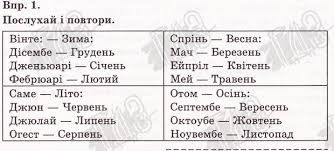

![]() USTENING COMPREHENSION
USTENING COMPREHENSION
Variant I
 О предмет
до iH-
О предмет
до iH-![]()
![]() Прослухай текст i постав «/»
тверджень, що
Прослухай текст i постав «/»
тверджень, що ![]() 3MicT0Bi тексту.
3MicT0Bi тексту.
1) ЈасК is from France. ![]() 2) ЈасК is nine. о3) ЈасК has а
brother.
2) ЈасК is nine. о3) ЈасК has а
brother.
оД) ЈасК lives in а house.
5) ЈасК likes Thursday and Friday.
6) ЈасК has Art оп Tuesday and Friday.
 Name: Аде:
Name: Аде:
Counfry:
НоЬЬу:
![]()
Favourife sporf: ![]()
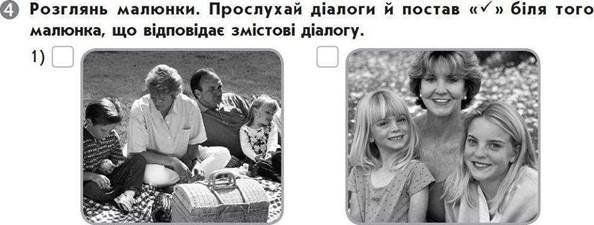
2) 
![]() USTENING COMPREHENSION
USTENING COMPREHENSION
Variant ll
 О
Прослухай текст. час прослуховування з'ЕднаЙ з його у kiMHaTi. Розфарбуй
малюнок
О
Прослухай текст. час прослуховування з'ЕднаЙ з його у kiMHaTi. Розфарбуй
малюнок

Прослухай текст i постав ![]() тверджень, що
тверджень, що ![]() 3MicT0Bi тексту.
3MicT0Bi тексту.![]()
о 1) Alice is from France.
2) AIice is ten. ![]() о З) AIice has а brother.
о З) AIice has а brother. ![]() о 4) Alice lives in а house.
о 4) Alice lives in а house.
о 5) AIice likes Tuesday and Friday.
6) AIice has Reading оп Tuesday and
Thursday.![]()
Прослухай i заповни пропуски на Тома.
 Name:
Name:
Аде:
Counfry: НоЬЬу:
![]()
Favourife sport:
![]()

2) 
READING
I
О![]() слова на групи
слова на групи ![]() до типу читання
до типу читання ![]() букви чи буквосполучення.
букви чи буквосполучення.
|
I'm from |
|
EngIand. |
dark, tea, car, in, Ьад, it, сатр, meet, park, teacherr sit, сап
![]()

![]()
Склади речення, поеднавши Тх початок з першого стовпчика i3
у другому.
|
Му hobby is |
|
10 0' clock. |
|
It's |
|
reading. |
|
I ат |
|
at Maths lessons. |
|
We count and do sums |
|
10. |
o n03Haq (0/» Aianor, LAO Bianoeiaa€ 3MiCTOBi Mamom«a.

![]() l ) a) — How old is Jane? b)
— How old is Jane? — She's eleven. — She's seven.
l ) a) — How old is Jane? b)
— How old is Jane? — She's eleven. — She's seven.
2) a) — Where's my book? b) — Where's my book?
![]() — It's on the chair. —
It's on the table.
— It's on the chair. —
It's on the table.
npoqhTai TeKCT. 3an0BHH nponycKH, BHKOPhCTOBY'0'4h
noaaHi cnoBa. ![]() npaBH"bHi
npaBH"bHi ![]() AO TeKCTY! nocTaB
AO TeKCTY! nocTaB![]()
days, Germany, football, at, Friday, is, games, on, to
Hans is from ![]() 10. He goes to school on
10. He goes to school on
Monday,
Tuesday, Wednesday, Thursday and ![]()
His favourife ![]() are Tuesday and Thursday: he has
Sport
are Tuesday and Thursday: he has
Sport ![]() these days. Hans likes playing
these days. Hans likes playing ![]() , running and jumping very much. His
favourite sport is
, running and jumping very much. His
favourite sport is![]() Hans goes a football club 10 0'clock
in the morning on
Hans goes a football club 10 0'clock
in the morning on
![]()
Saturday.
1) Hans is a schoolboy. 2) He doesn't go to school on Sunday.
a 3) Hans lives in France.
![]() 4) Hans
has Sport on Thursday and Friday. 5) Hans likes playing football.
4) Hans
has Sport on Thursday and Friday. 5) Hans likes playing football.
6) Hans doesn't play football on Saturday.
READING
II
О![]() слова на групи
слова на групи ![]() до типу читання
до типу читання ![]() букви
букви
чи буквосполучення.
|
and Sport. |
|
lt's eleven |
it, table, plane, hot, inr got, тит, fun, take, uncle, drum, favourite
![]()
![]()
![]()
![]()
Склади речення, поеднавши Тх початок з першого стовпчика i3
у другому.
|
Му пате is |
|
Ukraine. |
||||
|
|
|
|||||
|
|
|
|||||
|
We draw and paint |
|
Peter. |
||||
o n03Haq (0/» Aianor, LIAO Bian0Biaa€ 3MiCTOBi Mamom«a.
|
l ) |
a) — What time is it? |
|
|
|
— It's three o'clock. |
— It's one o'clock. |
2) ) — Is the cat in the b) Is the cat in bedroom? the kitchen?
— No, it's in the — No, it's in the kitchen. bedroom.
 npoqmai
TeKCT. 3an0BHH nponycKH, B"KOPHCTOBYIOMH noaaHi cnoBa. npaBHJ1bHi
TBePAY€eHH9 AO TeKCTY! nocTaB «V»
npoqmai
TeKCT. 3an0BHH nponycKH, B"KOPHCTOBYIOMH noaaHi cnoBa. npaBHJ1bHi
TBePAY€eHH9 AO TeKCTY! nocTaB «V»![]()
days,Tuesday, France, football, at, is, games, on, to
![]()
![]() Alice is
from
Alice is
from![]() She
She ![]() 12. She goes to school on Monday,
12. She goes to school on Monday,![]() Wednesday, Thursday and Friday. Her
favourite are Monday and Thursday: she has Artthese days. Alice likes drawing
and painting very much. She also likes dancing. She goes
Wednesday, Thursday and Friday. Her
favourite are Monday and Thursday: she has Artthese days. Alice likes drawing
and painting very much. She also likes dancing. She goes ![]() a dance club
a dance club![]() 11 0'clock in the morning on
Saturday.
11 0'clock in the morning on
Saturday.
![]() I) Alice
is a schoolgirl.
I) Alice
is a schoolgirl.
2) She doesn't go to school on Sunday. 3) Alice lives in France.
4) Alice has Art on Thursday and Friday.
5)
Alice likes
playing drawing and painting. ![]() 6) Alice doesn't go to a dance club.
6) Alice doesn't go to a dance club.![]()
WRlTlNG там)
I
О Склади словосполучення з поданих та запиши ti.![]()
![]() help to
school ,get Tuesday
help to
school ,get Tuesday ![]() 90 ту Мит
90 ту Мит ![]() watch а bike
watch а bike
![]()
оп ир ![]()
ride cartoons
Розглянь малюнок ферми й запиши назви тварин.

chicks
![]()
o P03rn9Hb MamoHKH aaV1 BianoBiAi Ha 3anmaHH9.![]()

What time does Mary get up? ![]()
![]()
What does Mary do at 9 0'clock?
![]()
When does Mary go to the tennis club?![]()
![]()
O CKnaAH P03noBiAb npo xnonuq KOCTY Ha OCHOBi TeKCTY.
Hello! My name is Kosta. I am 10. I am from Greece. My hobby is riding a bike. My favourite sport is football. I like painting very much.
His name is Kosta.
![]()
![]()
![]()
![]()
![]()
WRITING TERM)
Il
O CKnaAh cn0BocnonyqeHH9 3 noaaux cniB Ta 3anhL.uH
•13(.![]()
team the left ![]() play •the
play •the ![]()
![]() fly up
on chess
fly up
on chess ![]()
P03rn9Hb Mamo•HOK 
ducks
o
 P03rn9Hb
mantOHKH
P03rn9Hb
mantOHKH 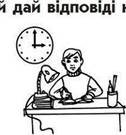 aaV1 BianoBiAi Ha 3anHTaHH9.
aaV1 BianoBiAi Ha 3anHTaHH9.
What time does Peter have breakfast? ![]()
![]()
What time does Peter do his homework?
![]()
What time does Peter go to bed?
![]()
![]()
o
CKnaAH P03noBiAb
npo xnonuq raHca Ha OCHOBi TeKCTa.![]()
Hello! My name is Hans. I am 9. I am
from Germany. My hobby is playing games. My favourite sport is tennis. I like
listening to music.![]()
His
name is Hans.![]()
![]()
![]()
![]()
![]()
SPEAklNG (ТНЕ TERM)
Variant 
О Запитай свого однокласника, з яко? BiH краћ\и, як його звуть,
попроси назвати СВОЕ по ![]() Дай
Дай ![]() на його запитання.
на його запитання.
 |
Розкажи однокласнику, яка в тебе улюблена спортивна гра; запитай його, чи грае BiH у цю гру, а також яка улюблена спортивна гра
У нього.
О Запитай свого однокласника, ![]() в нього Е: ЧИ Е в нього
в нього Е: ЧИ Е в нього
робот/ лялька/ м'яч.
Дай ![]() на його запитання.
на його запитання.
О Запитай свого однокласника, в нього
![]() уроки. Дай
уроки. Дай ![]() на його запитання.
на його запитання.
SPEAklNG (The FRST там) Variant Il
о Запитай свого однокласника, йому
P0kiB, з яко? BiH краћћи. Дай ![]() на його запитання.
на його запитання.
![]() Розкажи однокласнику, що ти любиш
робити у час. Запитай його, що BiH любить робити у час.
Розкажи однокласнику, що ти любиш
робити у час. Запитай його, що BiH любить робити у час.
о Запитай свого однокласника, ![]() в нього Е: чи Е в нього
в нього Е: чи Е в нього ![]() лялька/ машинка.
лялька/ машинка.
Дай ![]() на його запитання.
на його запитання.
о Запитай свого однокласника, який ![]() день тижня, в нього
день тижня, в нього ![]() тижня; дай
тижня; дай ![]() на його запитання.
на його запитання.
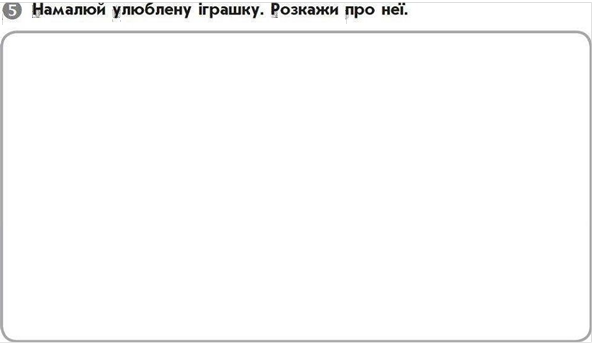
TESTS TEST 1 (UNlT 1 . lN ТНЕ GREENWOODS
SUMMER САМР) Variant![]()
![]() о
о
 |
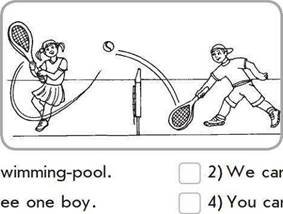 х
1) This is а swimming-pool. 2) We сап see опе girl.
х
1) This is а swimming-pool. 2) We сап see опе girl.
о 3) We сап see опе Ьоу. 4) Уои сап play tennis here.
о 5) Уои сап watch cartoons here. о 6) Уои сап play footba11 here. о 7) Уои сап swim here.
о Знайди слова, що римуються. Напиши '1Ъ(.
TEST 1 (UNlT 1. lN ТНЕ GREENWOODS
SUMMER САМР) Variant ll
о Встав![]()
Е п д а а ![]() l t
l t![]()
![]() а п с
а п с![]() е
е![]()

1) This is а party hall. о 2) We сап
see fwo girls.![]()
о З) We сап see two boys. о Д) Уои сап play tennis here. 5) Уои сап dance here. 6) Уои сап sing here. о 7) Уои сап swim here.
о Знайди слова, що римуються. Напиши![]()
|
|
|
||||||||||||||
|
сап |
|
реп |
|
to |
|
пате |
|
that |
|||||||
TESTS TEST 1 (UNlT 1 . lN ТНЕ GREENWOODS
SUMMER САМР) Variant![]()
![]() о
о
 |
 х
1) This is а swimming-pool. 2) We сап see опе girl.
х
1) This is а swimming-pool. 2) We сап see опе girl.
о 3) We сап see опе Ьоу. 4) Уои сап play tennis here.
о 5) Уои сап watch cartoons here. о 6) Уои сап play footba11 here. о 7) Уои сап swim here.
о Знайди слова, що римуються. Напиши '1Ъ(.
TEST 1 (UNlT 1. lN ТНЕ GREENWOODS
SUMMER САМР) Variant ll
о Встав![]()
Е п д а а ![]() l t
l t![]()
![]() а п с
а п с![]() е
е![]()

1) This is а party hall. о 2) We сап
see fwo girls.![]()
о З) We сап see two boys. о Д) Уои сап play tennis here. 5) Уои сап dance here. 6) Уои сап sing here. о 7) Уои сап swim here.
о Знайди слова, що римуються. Напиши![]()
|
|
|
||||||||||||||
|
сап |
|
реп |
|
to |
|
пате |
|
that |
|||||||
USTENING COMPREHENSlON (THE SECOND TERM)
Variant I
 |
 О Прослухай знаком «V» Розфарбуй одяг
О Прослухай знаком «V» Розфарбуй одяг
![]()
![]() Прослухай
Познач знаком «V» продукти, матуся кладе в салат.
Прослухай
Познач знаком «V» продукти, матуся кладе в салат.

o npocnyxaVf Aianor. n03Haq 3HaKOM «V» MamoHOK, Bian0Biaae 3MiCTOBi Aianory.

o
npocnyxai TeKCT.
nocTaB «V» 6ing Ha3B npo#ecii, 'Ki T" noqyew. npocnyxai TeKCT l.ue pa3.
nocTaB «V» 6in9 ![]() peqeHb, i «x»
peqeHb, i «x»
6ins HenpaBhJ1bHHX.
![]()
![]() driver o waitress
driver o waitress![]() teacher secretary sellerbusinessman
singer doctorwaiter
teacher secretary sellerbusinessman
singer doctorwaiter
dancer
1) Mr Evans is a businessman.
2) Mr Evans has a small café.
3) Three sellers work in the shop.
4) Mr Evans has a secretary.
5) Mr Evans starts work at 9 0'clock.
6) Mr Evans has breakfast in a café.
7) Mr Evans finishes work at 8.
TEST 4
(UNIT 4. W.'E ARE DIFFERENT) Variant I
o P03rn9Hb MamoHOK i nocTaB 6ing peqeHb, 140 Bian0Biaa10Tb "OMY,
6inR THX, LAO He BianOBiWOTb.
1)
 It's
winter.
It's
winter.
2) It's raining.
3) We can see a baby.
4) The boy is skiing.
5)
![]() The boy isn't wearing a scarf. 6) The
boy isn't wearing skates.
The boy isn't wearing a scarf. 6) The
boy isn't wearing skates.
BH6epH 3 APKOK npaBHnbHHii BapiaHT BiA110BiAi 51 BTIHLUM B peyeHH9.
1)
Whose dress is this? — It's( Vicky' s, Vicky). 2) Whose coat is this? — ![]() It's (him, his). 3) Whose doll is
this? — It's (her, hers). 4) Whose scarf is this? — It's
It's (him, his). 3) Whose doll is
this? — It's (her, hers). 4) Whose scarf is this? — It's ![]() (my, mine).
(my, mine).![]()
O npoqmai TeKCT. BH6epn VI 06BeAh npaBW1bHe cn0B0.
 This is
Cinderella. She is young and long/beautiful. She is not fat, but she is thin/
ugly. She has got short/ long blond hair. She is wearing/ crying a nice
This is
Cinderella. She is young and long/beautiful. She is not fat, but she is thin/
ugly. She has got short/ long blond hair. She is wearing/ crying a nice
dress and very small shoes/skafes. Look at her! What's she doing? She is flying/dancing with the Prince. He is weak/tall and strong. They are angry/happy.
TEST 4
(UNIT 4. 'W'E ARE DIFFERENT) Variant Il
![]()
 o P03rnßHb
MamoHOK i nocrae 6ing peqeHb, LAO Bian0Biaa10Tb "OMY, i «X» 6iJ19 THX, Luo
He BianOBiWOTb. I ) It's autumn.
o P03rnßHb
MamoHOK i nocrae 6ing peqeHb, LAO Bian0Biaa10Tb "OMY, i «X» 6iJ19 THX, Luo
He BianOBiWOTb. I ) It's autumn.
2) It's snowing.
3) We can see a girl.
4) The girl is skiing.
5) The girl is wearing a scarf.
6) The girl isn't wearing skates.
![]() BH6eph 3 A'PKOK npaBHnbHHi Variant
BianoBiAi ennu.l" B peqeHH9.
BH6eph 3 A'PKOK npaBHnbHHi Variant
BianoBiAi ennu.l" B peqeHH9.
![]()
![]()
![]() 1) Whose skirt is this? — It's (Kate's,
Kate). 2) Whose skates are these? — They're(your, yours). 3) Whose book is
this? — It's
1) Whose skirt is this? — It's (Kate's,
Kate). 2) Whose skates are these? — They're(your, yours). 3) Whose book is
this? — It's ![]() (my, mine). 4) Whose hat is this? It's(his,
he).
(my, mine). 4) Whose hat is this? It's(his,
he).
![]()
O
 This is
Alice. She is very young/ old and beautiful. She is not fat, she is thin/ ugly.
She has got long black/blond hair. She is watching/wearing a nice suif/dress
and shoes. Look at her! What's she doing? She is swimming/ reading. She is
sitting on the grass under/in the tree. She is happy/ sad.
This is
Alice. She is very young/ old and beautiful. She is not fat, she is thin/ ugly.
She has got long black/blond hair. She is watching/wearing a nice suif/dress
and shoes. Look at her! What's she doing? She is swimming/ reading. She is
sitting on the grass under/in the tree. She is happy/ sad.
TEST 6
(UNIT 6. IT'S MY WORLD) Variant I
o P03Ta1.uyi HOMepH peqeHb y Ta6JIHL4i 3ane»€H0 BiA Toro, nopa poKY onHCYETbC9.
1) Children can swim in the river.
2) It's cold.
3) Children don't go to school.
4)
The trees are
white.![]()
5) We have Easter.
6) It's often cold and it sometimes rains.
7) The days are short and the nights are long.
8) Children go to school after summer holidays.
9)
People plant
trees, flowers and vegetables. 10) It often snows.![]()
|
Winter |
Spring |
Summer |
Autumn |
|
|
|
|
|
npoqMTai TeKCT. 3an0BHH nponycKH, BH6paBWH npaBnnbHe cn0B0 ![]() cn0BocnonyqeHH9 3 APKOK.
cn0BocnonyqeHH9 3 APKOK.
 tails). It eats fruif/fish and meat).
tails). It eats fruif/fish and meat).
o P03c>ap6yV1 i aon0BHH MamoH0K Bian0BiAH0 AO iHCTPYKuii.

Colour the sun yellow. Colour the sky blue. Colour the leaves green. Colour the grass brown. Colour the river blue. Colour the flowers red. Colour the houses brown. Draw a fish in the river. Colour the boy's jumper yellow. Colour the boy's trousers gray. Colour the bag orange.
O P03rn9Hb MamoH0K u.le pa3. npaBHJ1bHi ![]() nocTaB
nocTaB ![]() 6iJ19 npaBhJ1bHHX i 6iJ1*
6iJ19 npaBhJ1bHHX i 6iJ1* ![]() 1) It's winter.
1) It's winter.
o 2) The weather is fine.
3)
![]() It's cold.
It's cold.
4) It's raining.
5) The sun is shining.
6) The sky is blue.
7) The wind is blowing.
8) There are a lot of flowers.
TEST 6
(UNIT 6. IT'S MY WORLD) Variant Il
o P03Tau.ryöi Honepn peqeHb y Ta6nnui 3ane»KH0 Bin Toro, "Ka nopa poKY onHCYETbCR. 1) Children can ski and skate.
2) It's hot.
3) People plant trees, flowers and vegetables.
![]() trees are
trees are![]()
5) We have Christmas.
6)
Birds don't sing
their songs.![]()
7) The trees are yellow, red and brown.
8) People plant trees, flowers and vegetables.
9) The days are long and the nights are short.
![]() 10) Children go to school after
summer holidays.
10) Children go to school after
summer holidays.
|
Winter |
Spring |
Summer |
Autumn |
|
|
|
|
|
![]() npoqmai TeKCT. 3anoBHh nponycKH,
BH6paBWH npaBHJ1bHe cn0B0
npoqmai TeKCT. 3anoBHh nponycKH,
BH6paBWH npaBHJ1bHe cn0B0 ![]() cnoeocnonyyeHH9 3 APKOK.
cnoeocnonyyeHH9 3 APKOK.
A crocodile lives in
 (rivers/foresfs).
It is (blue/green). It has got a long (tail/leg) and a big
(rivers/foresfs).
It is (blue/green). It has got a long (tail/leg) and a big
(ear/mouth). It has got short
(legs[tails). It eats ![]()
(leaves and fruif/fish and meat).
 O
P03+ap6yi i AOKIOBHH MamoHOK BianOBiAHO AO iHcTpyK14ii.
O
P03+ap6yi i AOKIOBHH MamoHOK BianOBiAHO AO iHcTpyK14ii.
Colour the bunny brown. Colour the hollow black. Colour the sun yellow. Colour the leaves green. Colour the grass green. Colour the flowers blue. Draw two clouds in the sky. Colour the girl's dress orange. Colour the boy's jeans blue. Colour the boy's T-shirt yellow. Colour the rug red.
P03rn9Hb mantOHOK u.xe pa3. YH
npaBhJ1bHi ![]() nocTaB «V» 6in9 npaBMJ1bHHx i «x» 6ing
HenpaBHnbHHX.
nocTaB «V» 6in9 npaBMJ1bHHx i «x» 6ing
HenpaBHnbHHX.
1
![]() ) It's
summer.
) It's
summer.
2 The weather is bad.
3 It's hot.
4
It's snowing.![]()
5 The sun is shining.
6 The wind is blowing.
7 It's wet.
8 The children are on a picnic.
-
Дякую за матеріал.


про публікацію авторської розробки
Додати розробку
